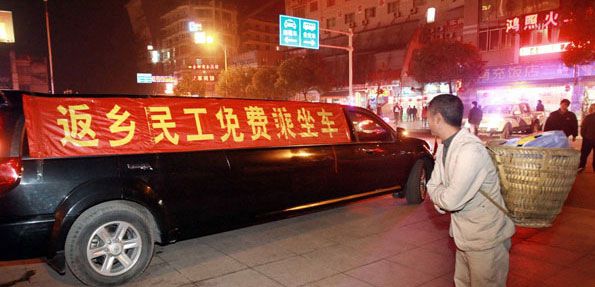人口流动模式改变:欢迎回家
|
爱思英语编者按:据报道,一项国家社科基金青年项目的研究成果指出,随着农村人口流入城市的规模不断增大,农村人口无序流动给城市和农村发展都带来严重挑战,中国构建农村人口有序流动的调节机制迫在眉睫。 Changing migration patterns 人口流动模式改变 Welcome home 欢迎回家 After three decades of migrating to the coast, the inland population is increasingly working closer to its roots. 三十年来内陆人口一直在向沿海流动,而如今他们当中越来越多的人选择回家工作。
“RETURN to your hometown to work and care for your family”, reads a red banner strung over the main street of Fuxing, a hillside town in the heart of China. Until recently, farmers in surrounding villages dreamt only of getting away from their pumpkin patches and earning good wages in factories on the coast more than 1,000km (625 miles) away. Officials were happy to be rid of them. Now they are desperate to get them to stay. “回家工作,关心家人”,这是悬挂在福兴大街上的红色条幅上写的的标语。福兴是中国内陆山腰上的一个小镇。直到最近,周边村庄的农民都还只想着离开自己的一亩地,到1000公里(625英里)以外的沿海工厂打工赚钱。政府官员曾经很乐见他们离开,而现在却急切地盼望他们能够留下。 Jintang county, to which Fuxing belongs, once enjoyed the dubious honour of being the biggest labour-exporting county in Sichuan province. Poor, deep inland and badly connected with overseas markets, Sichuan had little choice but to encourage its huge, underemployed rural population to find work elsewhere. Officials from counties like Jintang used to tour factory towns near the coast touting the merits of their surplus labour— and trading on the stereotype of the tough and determined Sichuanese. 福兴镇所属的金堂县曾经是四川最大劳务输出地,贫穷落后,地处内陆偏远地区,和海外市场的联系不紧密,对此,四川别无选择,唯有鼓励当地庞大的农村待业人口到其他地方找工作。县官员们曾经到沿海工厂区巡游,宣传他们过剩的劳动力——坚强困苦的传统四川人。 In the 1980s and 1990s the number of people from Jintang who were working elsewhere grew from almost nothing to 180,000 (out of a population of 900,000). More than a third of them went to factories in Guangdong province (see map), the first area in China to cash in on the country’s export boom. China’s migrant workers like to stick close to others from their hometown, and many of Jintang’s workers ended up in a single district of Dongguan, a centre of labour-intensive production in Guangdong, making everything from electronics to clothing. A street in Dongguan became known as Little Jintang. Chinese media say the Communist Party chief of Jintang used to visit local factories to persuade them to hire his county’s migrants. Six years ago Jintang set up an office in Dongguan for this purpose. 八九十年代,在外工作的金堂人数量从零飙升至180,000(总人口为900,000),超过1/3的人在广东省的工厂打工,广东是全国第一个靠出口赚钱的地区。中国的民工喜欢和老乡聚在一起,许多金堂打工者聚集在东莞(广东的劳动密集型生产中心,生产各种东西:从电子产品到服装)的一个地区,东莞的一条街甚至被称为“小金堂”。中国媒体报道说金堂县党总书记曾到当地劝说工厂方面雇佣金堂民工。6年前,金堂还为此在东莞设置了一个办公室。 The lure of home 回家的诱惑 A big change is now coming. Jintang is administered by Sichuan’s capital, Chengdu, which like other inland cities is beginning to boom, thanks to a flood of government investment in recent years and the transfer of some manufacturing away from the coast in search of cheaper land and labour. In Fuxing walls and lampposts are plastered with job advertisements, not for work in distant coastal factories but for positions in and around Chengdu. Some of them offer jobs with Foxconn, a huge Taiwanese firm which makes Apple’s iPads and other computer products at a plant near the city (for pay of more than 2,000 yuan—$320—a month, says one pink poster). Foxconn’s largest factory is in Guangdong, but it opened a huge, modern operation in Chengdu in October 2010, and has talked of expanding to an astonishing 500,000 staff within five years. Chengdu officials have been scrambling to make sure that as many jobs as possible go to locals (who appear undeterred by a number of unexplained suicides at Foxconn’s huge plants in China). 而现在金堂县正发生着巨大的变化。像其他内陆城市一样,金堂县现在归四川省会城市成都市管辖,受益于近几年的政府投资以及生产业由沿海转移到廉价土地和劳动力的地方,金堂正蓬勃发展。在福兴大街的墙上以及灯柱上贴满了招聘广告,但不再是为了沿海工厂而招聘,而是在当地以及成都附近提供岗位。有些提供了富士康的岗位,富士康是台湾的一家大公司,在成都附近的一个工厂生产苹果iPad和其他电脑产品,一则粉红色的广告写着:每月工资最低2,000元(320美元)。富士康最大的工厂在广东,但该公司于2000年10月在成都开设了一个现代化大工厂,据说5年内将扩充员工数量至500,000人。成都官员们争相为当地争取更多就业机会,这似乎并未因为富士康员工自杀事件而受到阻碍。 By a roadside in Fuxing, a few dozen young men and women from the surrounding countryside wait with piles of baggage for a bus to take them to Chengdu (though technically in Chengdu, Fuxing is two to three hours’ drive away from the city proper, much of it along a winding country road). It is just after the lunar new year holiday, a time when migrant labourers have for more than two decades returned to the coast after spending the festival in their home villages. But for many of those at the bus-stop, Chengdu is their final destination. They crowd around your correspondent, regaling him with stories of how wages in Chengdu are now not much lower than on the coast, and how jobs nearby are getting easier to find. 在福兴镇路边,一群来自附近农村、提着大包的年轻人在等待去成都的公交车(虽然福兴镇在成都,但离主城区有两三个小时的环城距离)。农历新年假期过后,正是民工在家乡过完年后回到沿海地区工作的时候。但对很多等公交的人来说,成都是他们的终点站。他们聚在记者周围,告诉记者现在成都的工资不比沿海地区的低多少,附近的工作越来越好找。 In a change with implications that resound beyond this small, remote corner of China, such stories mark the beginning of the end of a phase in China’s development: one that was marked by lengthy journeys and often miserable lives in faraway, Dickensian factories. Isolated Fuxing will soon be just a few kilometres from an expressway. Villagers are excited about the new road, not only because it will make travel to Chengdu much easier, but because it will bring business and job opportunities closer. Workers in Fuxing are putting the finishing touches to a large new open market and shopping complex. 在这些偏远的小角落所发生的事标志着中国的一个发展阶段的结束,即长途跋涉到远离家乡的工厂工作并艰难生活的结束。封闭的福兴镇离高速公路的距离很快就会只有几千公里。小镇居民对修建新路很兴奋,不仅仅是因为去成都更加方便,更是因为新路会给这个小镇带来商业发展和就业机会。现在,福兴的新兴市场和购物中心即将完工。 Officials across the county have been busying themselves with what until three or four years ago would have been an unthinkable task: persuading migrants to stay in Jintang after the new-year festivities rather than go back to the coast. They hold meetings with migrant-worker representatives and offer tax breaks and help secure loans for those wanting to start up businesses. A government-owned newspaper in Chongqing, a region neighbouring Sichuan, even published a photograph of policemen carrying the bags of migrants returning to spend the new-year holiday there. In a country where officials (and long-established city-dwellers) often view migrant workers with disdain, the signal was clear: welcome home. A stretch limousine was provided by a Chongqing boss as a free shuttle service for the workers (see picture above). 全县的官员都在劝导民工节后不要回沿海地区,留在金堂,而这在三四年前是个想都不敢想的任务。他们和民工代表开会、为想要创业的人提供减税优惠以及贷款担保。重庆(与四川相邻)一家政府报纸甚至刊登了一张民警为回家过节的民工拎行李的照片。在中国这样的国家,政府官员和当地常住居民经常瞧不起民工,“欢迎回家”成为一个明显的信号。一个重庆老板为他的员工提供加长豪华车免费送他们回家。 Officials say that in 2011, for the first time, the number of local labourers migrating from one part of Chongqing region to another exceeded the number leaving for other provinces. Just a few years ago, 70% were going elsewhere. Xinhua, a state-run news agency, reported that since 2008, four-fifths of people leaving their homes for the first time in Henan, another big exporter of labour, had been migrating within Henan. Before then, it said, the same proportion had left for other provinces. In Sichuan the trend has been similar. In 2008, 58% of its 20m migrants were working outside the province. Last year the ratio dropped to 52%. A labour official in Chengdu says enthusiasm for staying close to home has been especially marked this year. One factor, he says, has been the difficulty that Europe’s downturn has caused coastal factories producing export goods. (By no means all of the new jobs being created inland are in the export sector, the traditional employer of migrant labour.) 政府官员表示,2011年,重庆当地的民工流动数量第一次超过了向外流动的民工数量。就在几年前,70%的民工到外地打工。国有新闻机构新华社报道,自2008年起,另一个劳务输出地河南——曾经有4/5的民工外出打工——现在他们第一次开始在省内流动。此前,其他省份也是同样的状况。四川的发展趋势和河南是类似的。2008年,2000万民工中,58%的人在外省工作。去年,这个比例降低到52%。成都一名劳务官员表示,今年,民工回家工作的热情尤为强烈。他表示,欧洲市场低迷导致沿海工厂生产出口商品有困难。(并非所有内陆地区的新工作都是在雇佣民工的传统出口部门) Migration over huge distances will remain a striking feature of China’s labour market for years to come. Employment along the coast suffered huge disruption late in 2008 as a result of the global financial crisis, with millions of migrants losing their jobs. But it quickly recovered as exports revived and stimulus measures helped spur growth. Now coastal factories are back to hand-wringing about a shortage of labour, notwithstanding the dark shadow cast by Europe’s misfortunes. 未来几年内,中国的劳务市场将持续呈现远距离民工流动的特征。2008年底,由于全球金融危机,沿海就业遭受打击,上百万民工失业。但随着出口恢复、鼓励措施促进了经济增长,就业市场很快恢复了繁荣。而今沿海工厂因劳动力短缺陷入了绝望之中,尽管欧洲的不幸投下了阴影。 But recent changes in migration patterns, though they are only just beginning, may be more than temporary distortions caused by troubled Western markets. They reflect China’s evolving economy and its ageing population. Even deep in the interior, the days of an abundant and apparently endless supply of cheap, young labour are over. The number of 15- to 29-year-olds peaked last year, according to UN estimates, and the working-age population as a whole will begin to decline in a few years. More than 90% of people under 30 from rural areas are already engaged in non-agricultural work, according to a report last year by the Development Research Centre, a government think-tank. So pressed are some businesses in Chongqing and Sichuan for semi-skilled labour that officials this year helped companies from the two regions to visit other provinces in search of workers. 但最近人口流动模式的改变(尽管只是刚刚开始)可能不只是因西方市场的困境而造成的暂时扭曲。它们折射了中国的经济发展和人口老龄化。即使在内陆深处,充足廉价的年轻劳动力的时代也已成为过去。据联合国估计,15—29岁的劳动力数量去年已经达到顶峰,并且在几年内,适龄劳动人口将整体呈现下降趋势。根据发展研究中心(一个中国智囊团)去年的报告,超过90%的30岁以下农村人口已经在从事非农业工作。重庆和四川的一些企业对半熟练技术工人的需求压力很大,以至于政府今年帮助这两地的公司到其他省份寻找工人。 The shift in migration patterns may also reflect a rebalancing of China’s economy. Domestic demand has made a bigger contribution to China’s growth in recent years, driven by heavy investment in infrastructure and property. To serve this expanding internal market, firms do not need to nestle close to a port. The result is a fast-narrowing wage gap between the coast and the interior. In 2004 coastal wages for migrant labourers were 15% higher than inland, according to a survey by the National Bureau of Statistics. Now, many workers in Sichuan say that taking into account transport costs and higher living expenses on the coast, less well-paid jobs closer to home are beginning to look much more competitive. 民工流动模式的改变也可能反映了中国经济的再平衡。近几年,受基础设施和房地产市场的投资驱动,国内需求大大促进了中国经济的增长。为了服务于这个快速发展的内陆市场,公司没必要向港口靠近。其结果是:沿海和内陆的工资差距日益缩小。根据全国统计局的调查显示,2004年,沿海地区民工工资比内陆地区高15%。许多在四川的民工表示,考虑到沿海地区的交通费和高额生活费,工资相对较少但离家近的工作日益变得更加有竞争力。 Experiments are under way in Chengdu and its environs, as well as in Chongqing, aimed at making it easier for migrants in urban areas to enjoy the same welfare benefits as registered city-dwellers. Lack of access to such benefits, particularly to urban schools, subsidised housing and health care, is a big problem for migrants. Many leave their children behind in their villages to be looked after (often not very attentively) by grandparents or other relatives. 在成都及周边地区、还有重庆,旨在让城市民工更容易地享受同当地居民同样福利的实验正在开展。对民工来说,享受不到这些福利待遇(尤其是城市学校、政府补贴住房)和医疗保健是最大的问题。许多民工把孩子留在农村,交给他们的外公外婆或其他亲戚看管,但通常都不能得到很好的照顾。 Between August 2010 and December last year, Chongqing awarded full urban-welfare rights to 3m migrants from its rural hinterland who had lived for a certain period in urban areas. Chengdu plans to eliminate welfare-related barriers to migration within the city boundary by the end of this year. This will mean that Fuxing’s farmers will be able to migrate to the city proper and enjoy the same benefits as were once enjoyed only by holders of urban hukou, or household-registration papers. The farmers will also be allowed to keep their land-use rights in the countryside. The reforms impose a big financial burden on local governments, but for the moment Chongqing and Chengdu—buoyed by a surge of government-led investment—are enjoying the kind of boom that was once confined largely to the coast. Chengdu boasted 15.2% growth in 2011, while Chongqing says its GDP grew 16.4%, faster than almost every other provincial area. The shift will create new problems even as it solves others, but it heralds a change of huge consequence for China’s hitherto unbalanced development. 2010年8月到去年12月间,重庆给予那些在城市生活了一定期限的300万农村腹地的民工享受全部城市福利的权力。成都计划在今年年底消除城市边界针对对民工的相关福利障碍。这将意味着福兴镇的农民可以迁移到城区并享受原本只有城市户口或房产持有人才能享受的福利,同时农民还可以保留乡下土地的使用权。这项改革对当地政府财政是一笔巨大的负担,但眼下重庆和成都——受政府主导投资的鼓励——正在经历着原来只有沿海地区才有的经济繁荣。2011年,成都GDP增长了15.2%,重庆增长了16.4%,几乎比其他任何一个省会地区都快。这种转变会产生一些新的问题,即使解决了一部分。但它预示着迄今中国不平衡的发展所带来的后果的转变。
|









